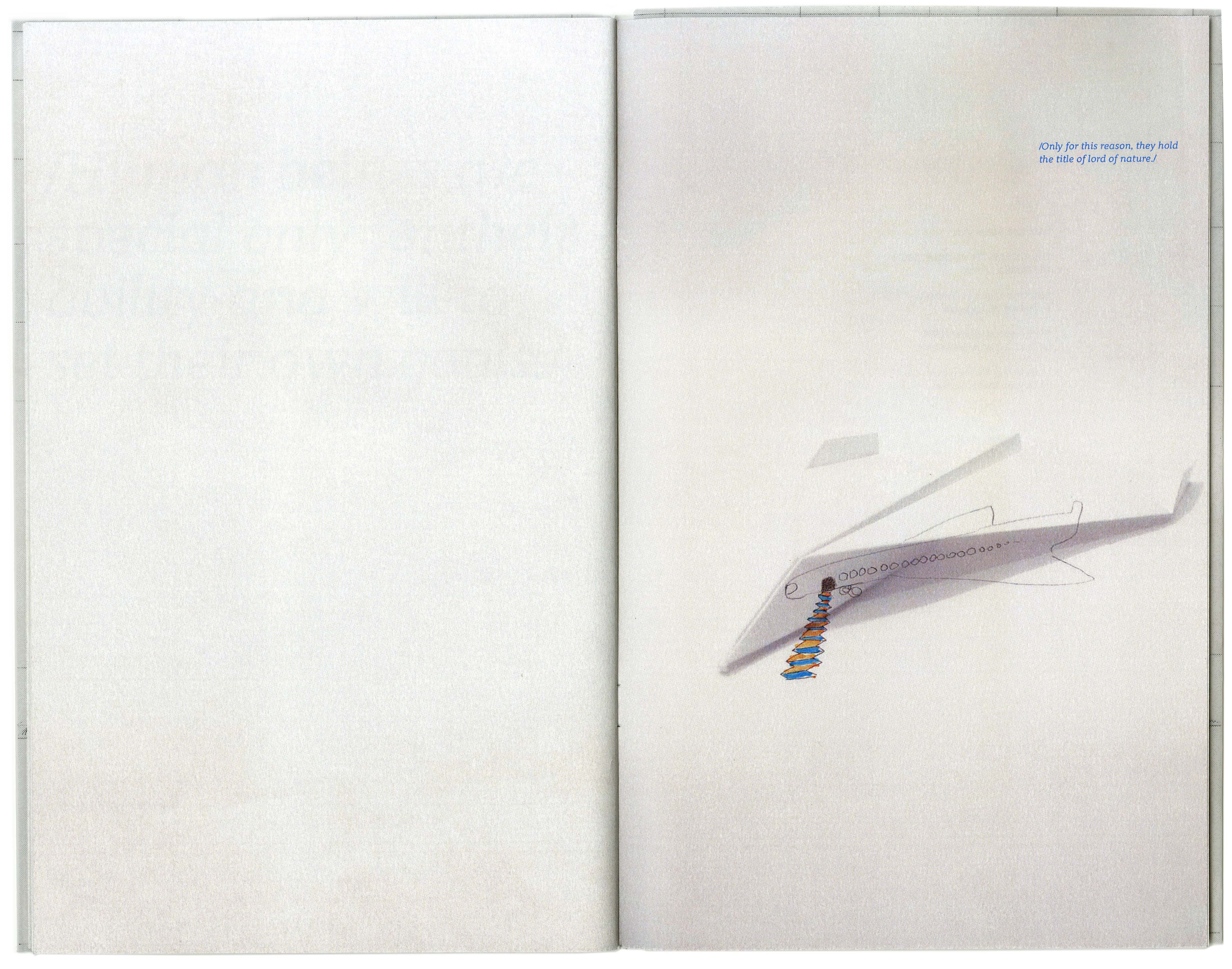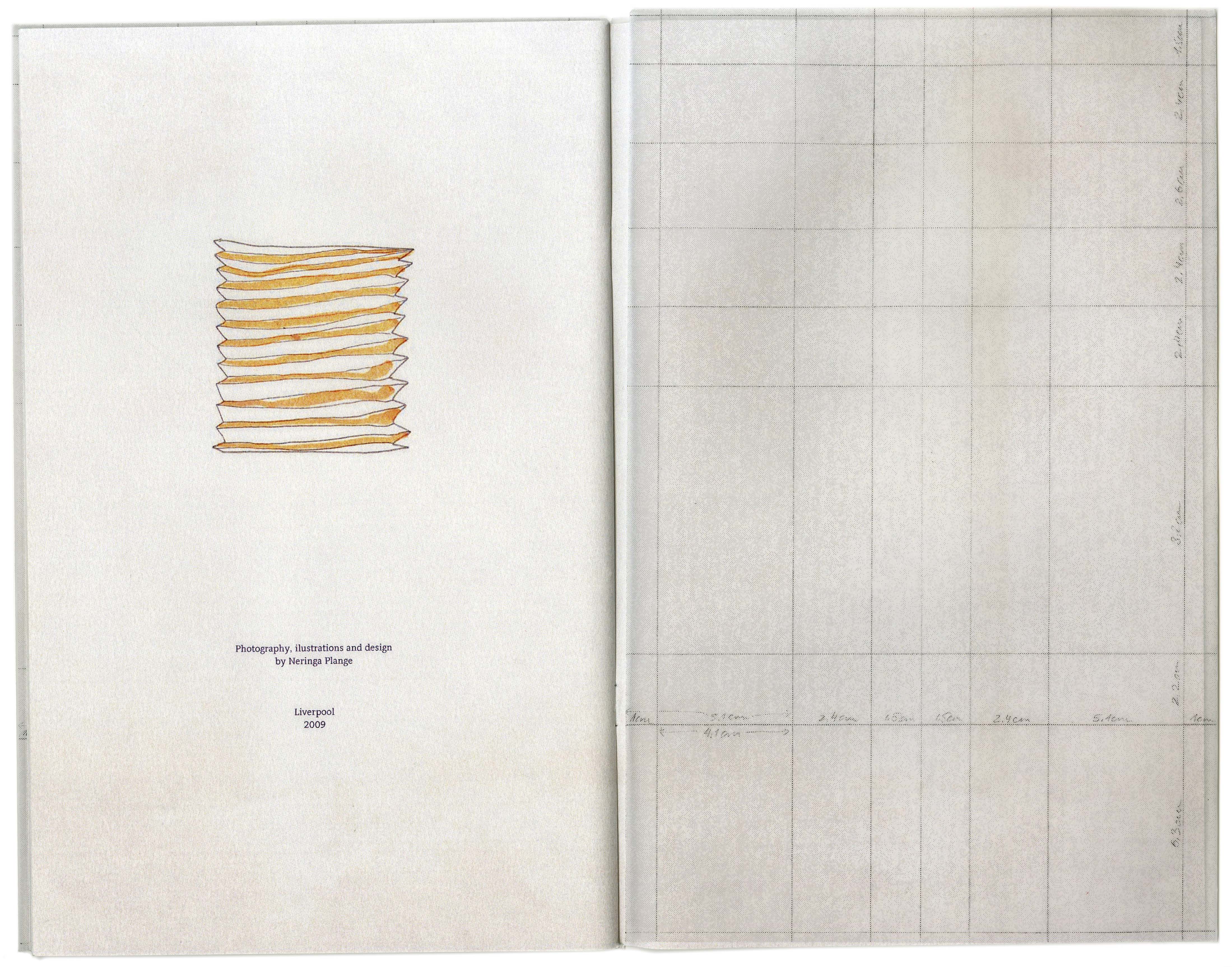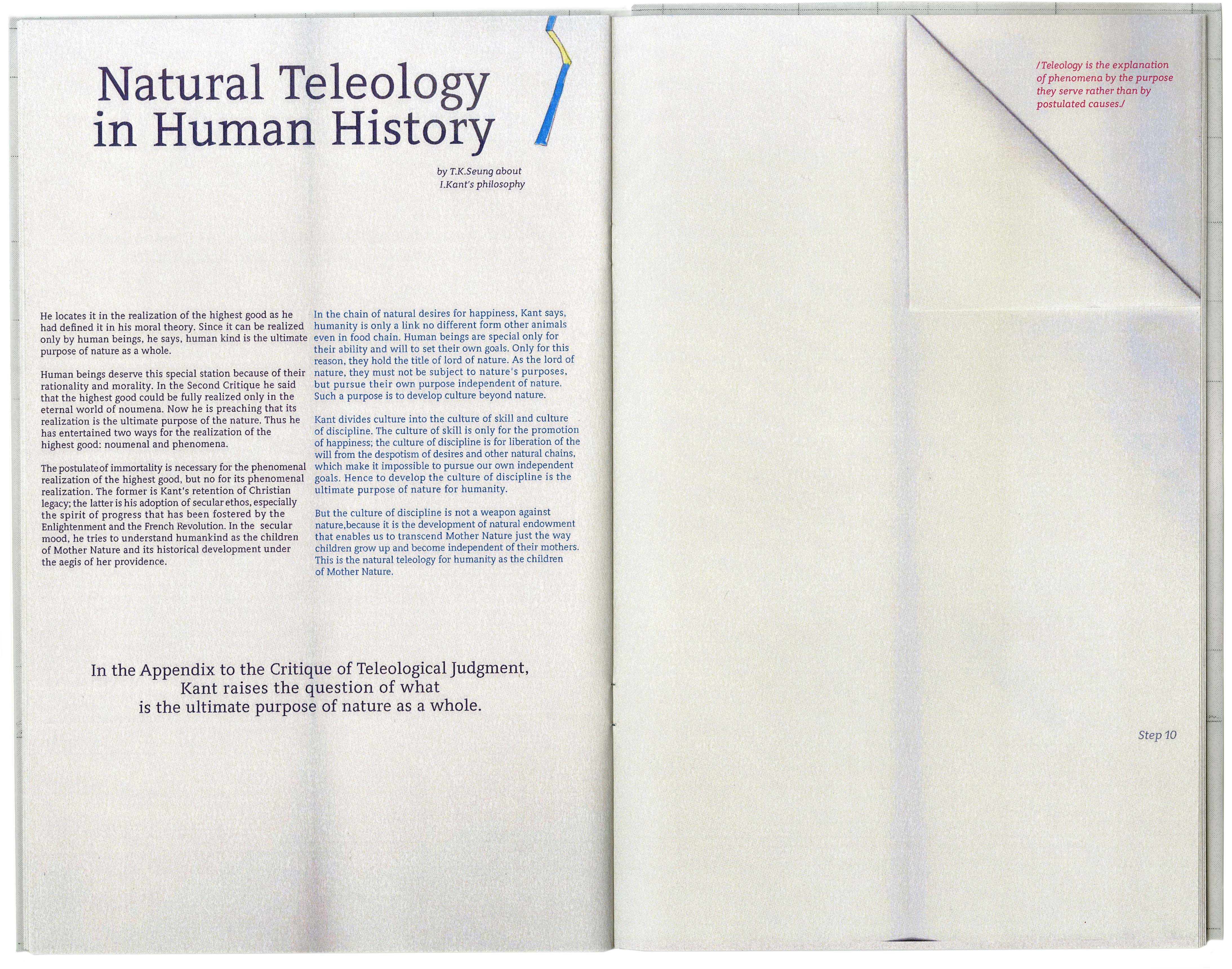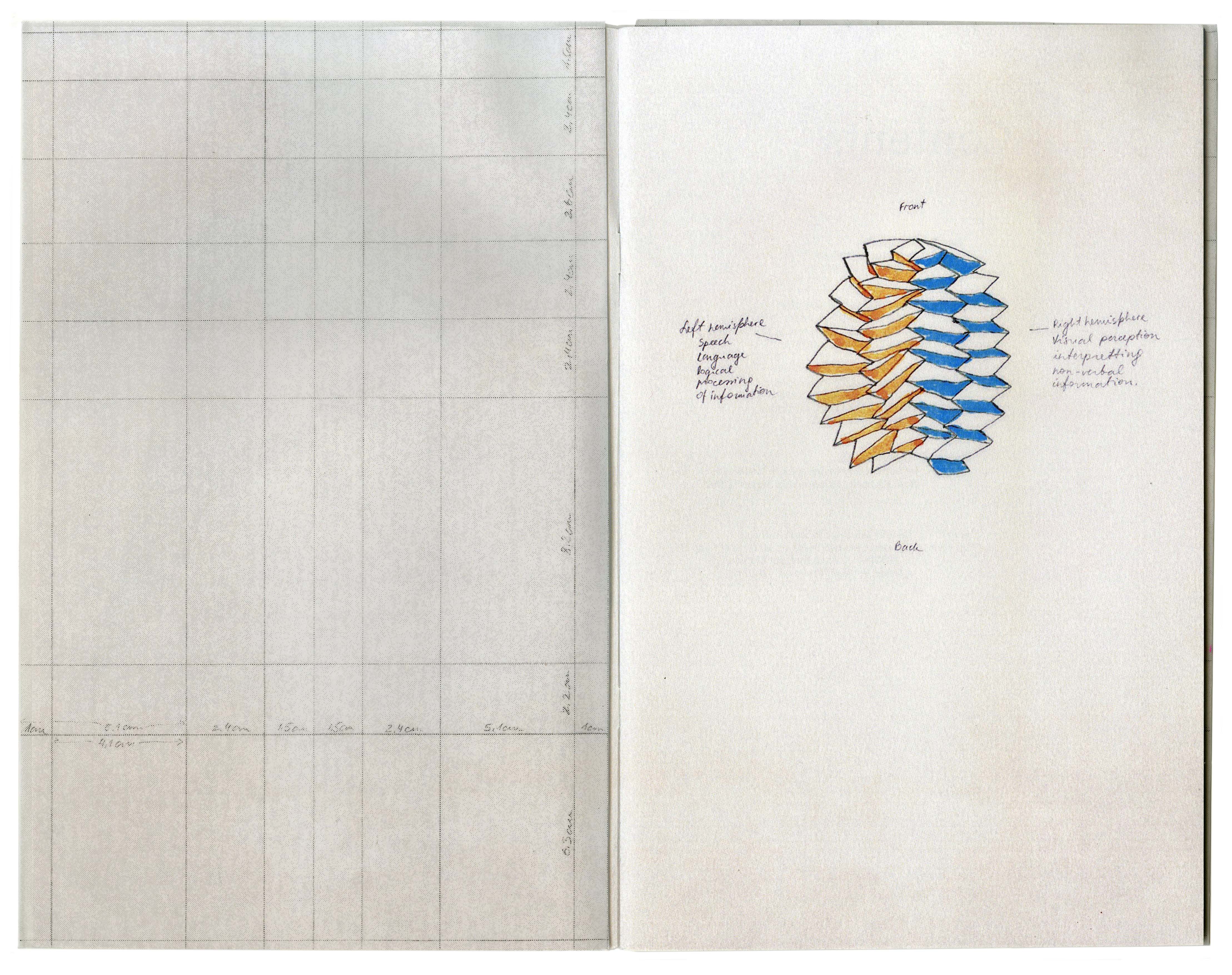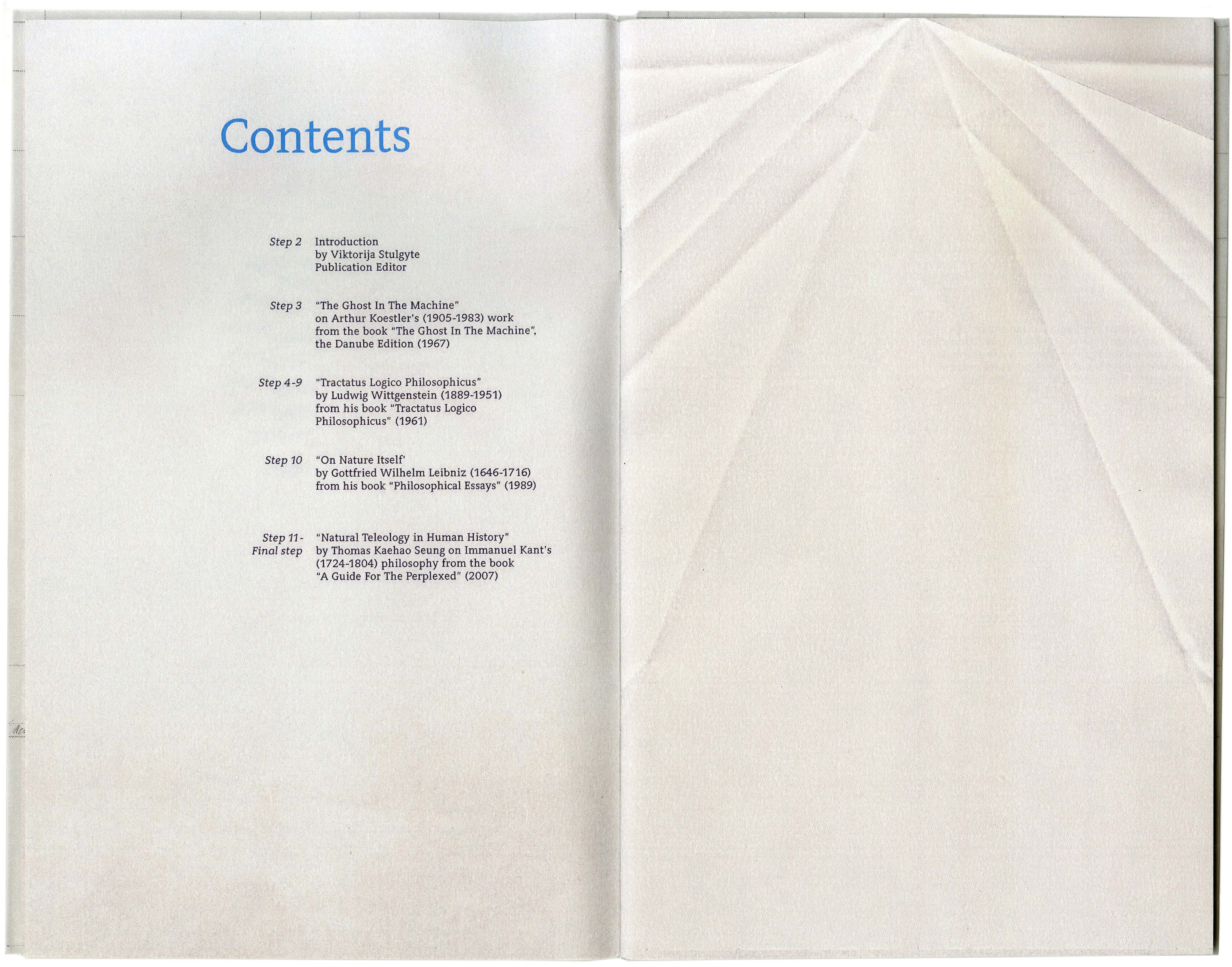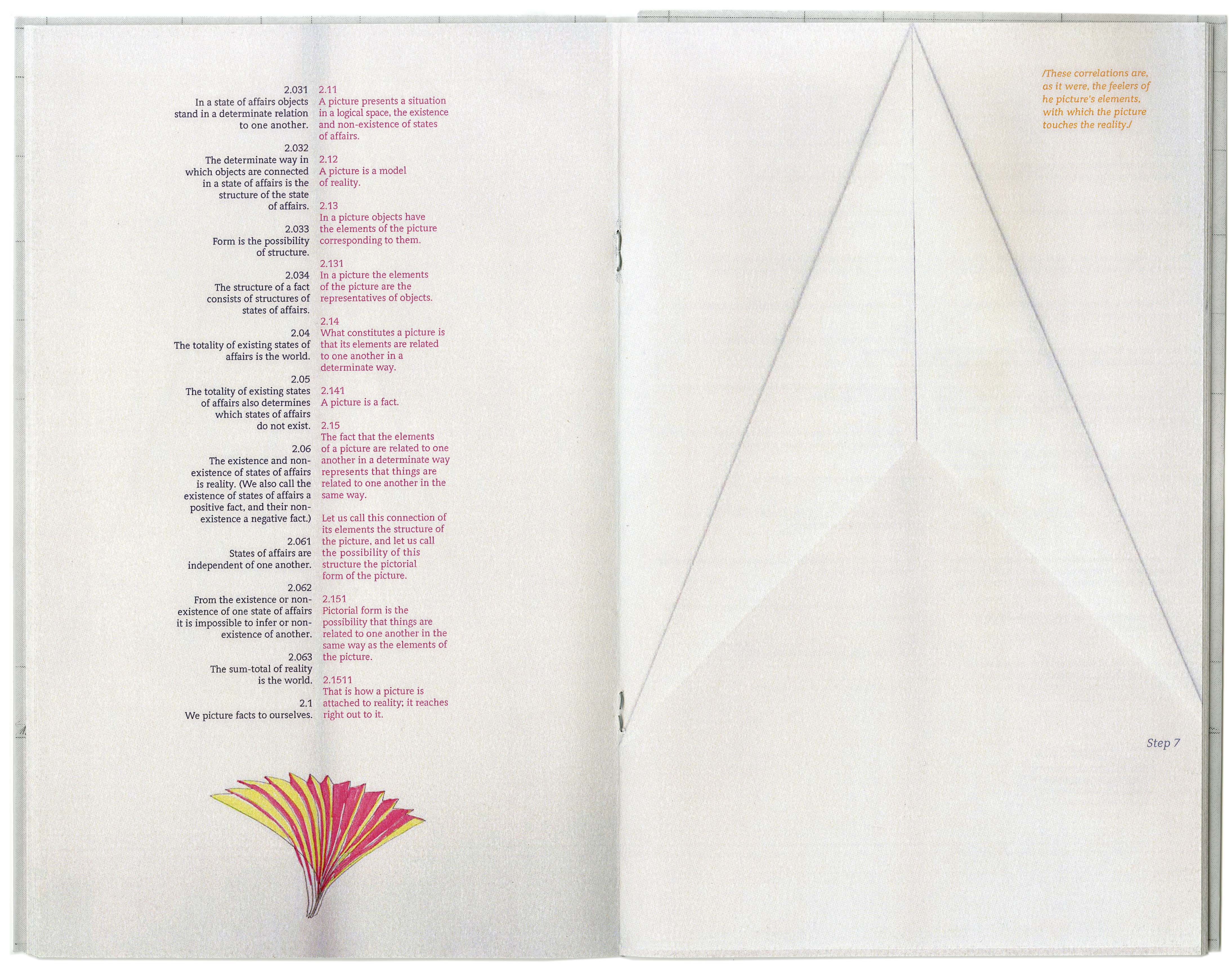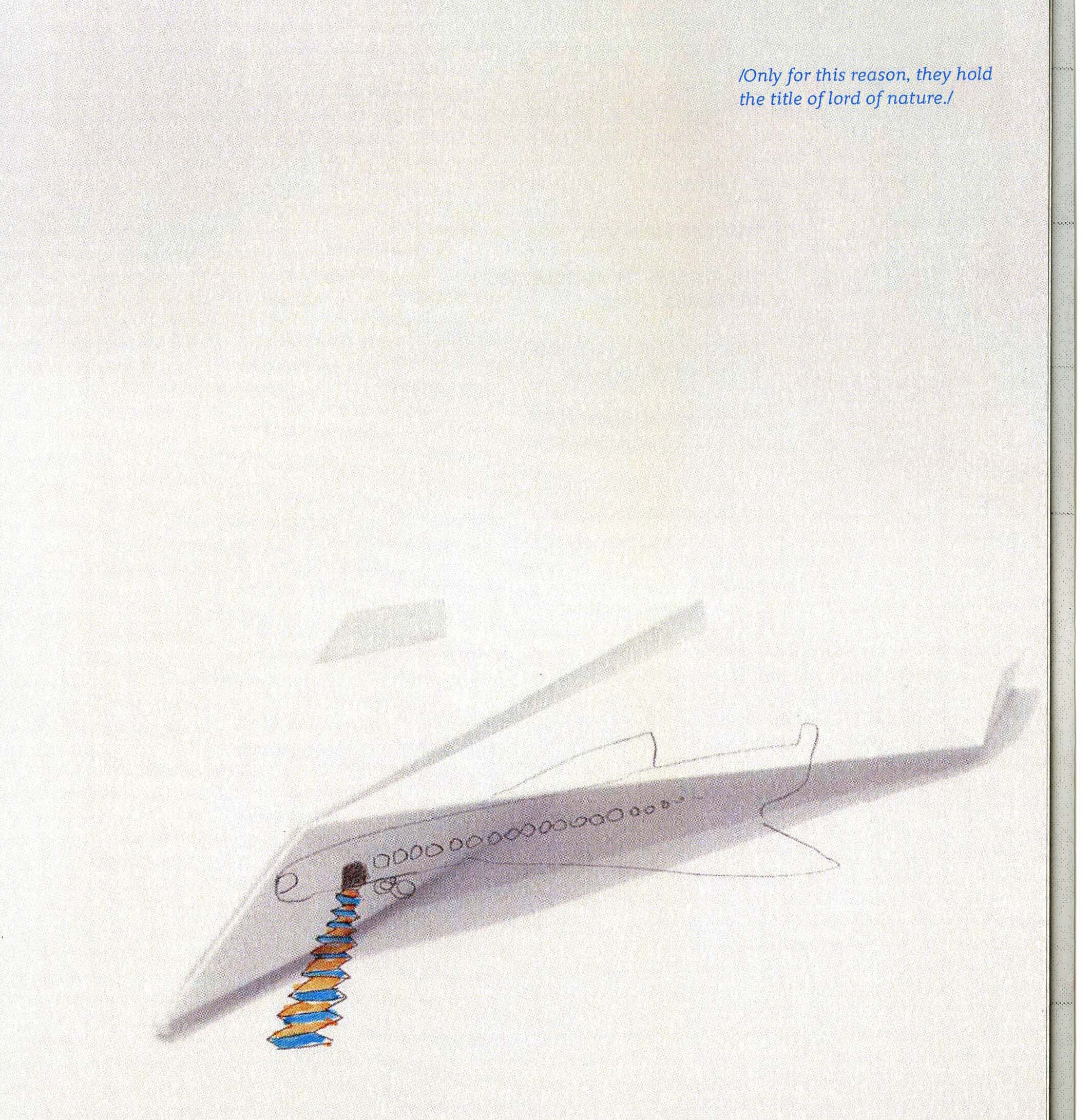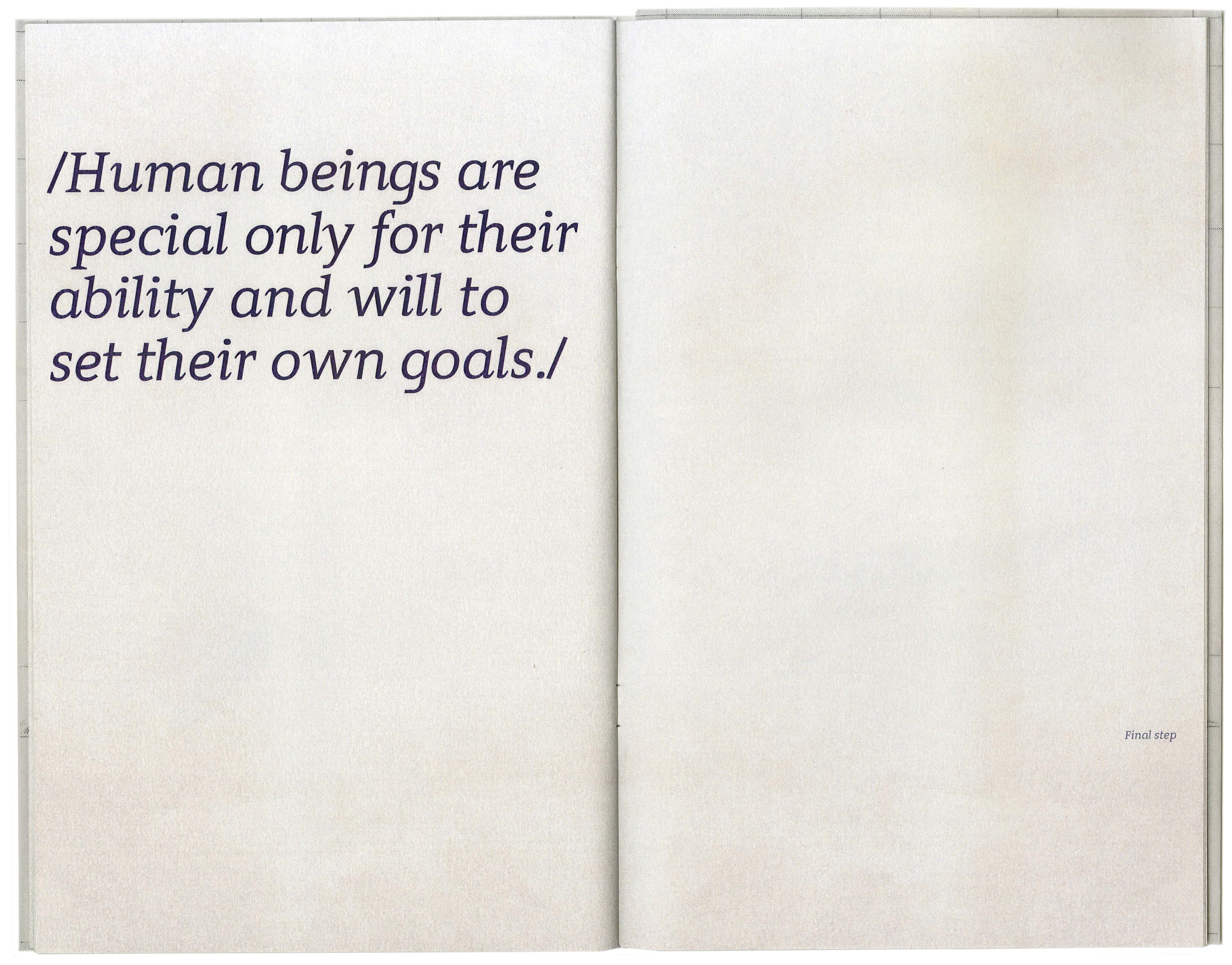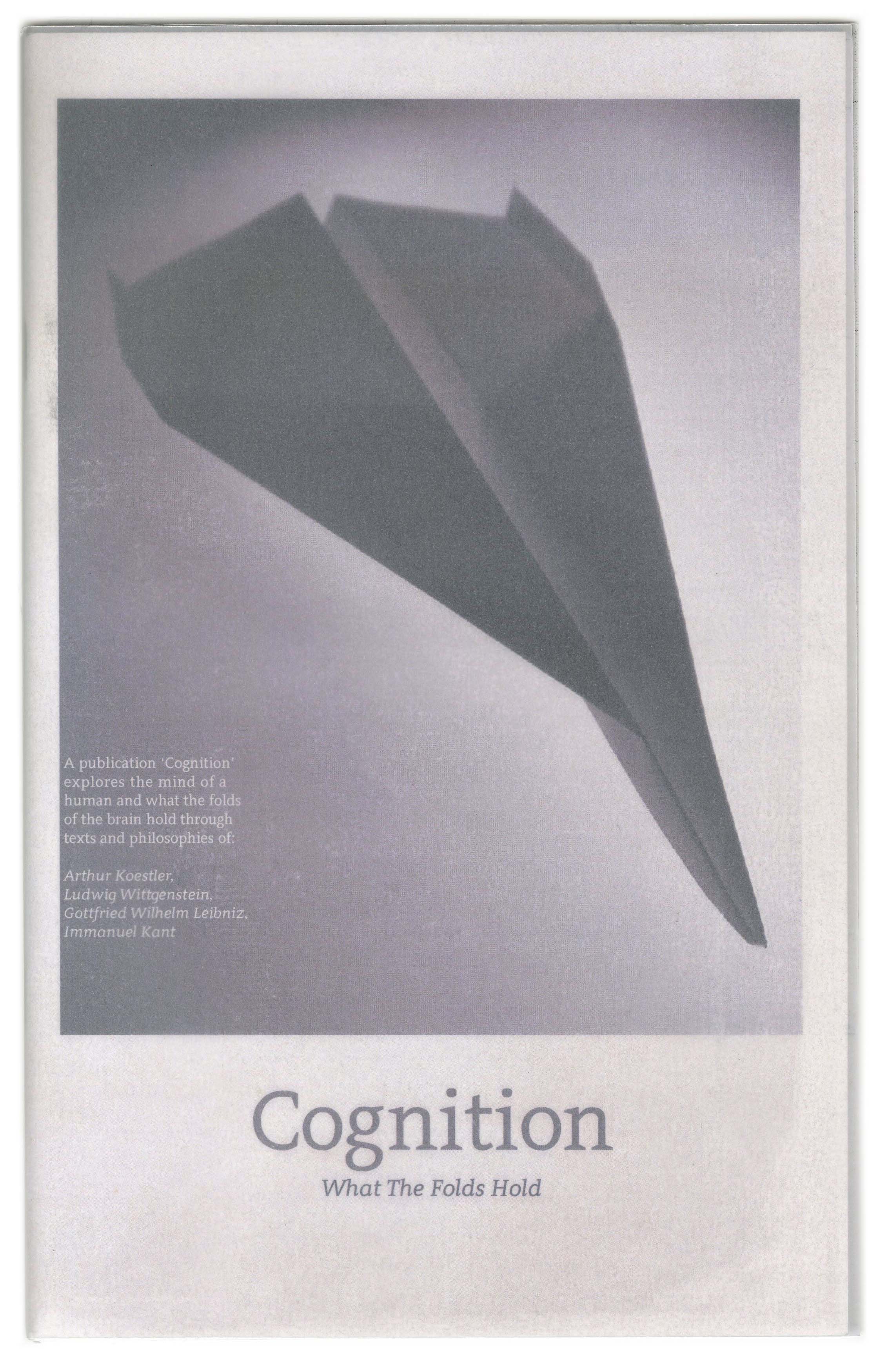Spread, Cognition: what the folds hold
Artist Book
Contents editing, typesetting, illustrations & photography
Edition of two, 24 pages, 180 x 240mm (portrait), typeface Contra
A publication interpreting the way we comprehend and investigates what cognition is. Cognition happens in the brain whilst learning through play, i.e. making paper planes. The layout design is based on the grid based on the folds of an unfolded paper plane. Publication consists of thought provoking texts which challenge the mind as the reader engages. Instead of page numbers here we have: Step 1, Step 2 and so on just as we learn in steps. The text is placed on the left hand side of the book as humans use the left side of the brain to read, and images are placed on the right hand side page as humans use the right side of or brain for visual interpretation.
The process.
It is again about the investigation of the subject matter: what is cognition, what makes it, what shapes it, what is the world of cognition internally and externally? What are the physical and theoretical (philosophical, psychological or any other) elements that make it or can be associated with it? By taking it apart, so to say, I then have those elements separately in order to create something else. To build a new space for the subject matter to manifest - in this case for the cognition to emerge in its purest form from a very directed manner. By mixing texts on a grid based on paper folds and by adding quirky illustrations, renaming page numbers to steps it creates a new order, unseen and unrealised before. It creates a new space for the mind to explore and hands to run through...
Using this process is rather comical to be able to present something so complex in such a simplified form. Yet paradoxically it leaves space for the reader's imagination.
Spread, Cognition: what the folds hold
Artist Book
Contents editing, typesetting, illustrations & photography
Edition of two, 24 pages, 180 x 240mm (portrait), typeface Contra
A publication interpreting the way we comprehend and investigates what cognition is. Cognition happens in the brain whilst learning through play, i.e. making paper planes. The layout design is based on the grid based on the folds of an unfolded paper plane. Publication consists of thought provoking texts which challenge the mind as the reader engages. Instead of page numbers here we have: Step 1, Step 2 and so on just as we learn in steps. The text is placed on the left hand side of the book as humans use the left side of the brain to read, and images are placed on the right hand side page as humans use the right side of or brain for visual interpretation.
The process.
It is again about the investigation of the subject matter: what is cognition, what makes it, what shapes it, what is the world of cognition internally and externally? What are the physical and theoretical (philosophical, psychological or any other) elements that make it or can be associated with it? By taking it apart, so to say, I then have those elements separately in order to create something else. To build a new space for the subject matter to manifest - in this case for the cognition to emerge in its purest form from a very directed manner. By mixing texts on a grid based on paper folds and by adding quirky illustrations, renaming page numbers to steps it creates a new order, unseen and unrealised before. It creates a new space for the mind to explore and hands to run through...
Using this process is rather comical to be able to present something so complex in such a simplified form. Yet paradoxically it leaves space for the reader's imagination.
Spread, Cognition: what the folds hold
Artist Book
Contents editing, typesetting, illustrations & photography
Edition of two, 24 pages, 180 x 240mm (portrait), typeface Contra
A publication interpreting the way we comprehend and investigates what cognition is. Cognition happens in the brain whilst learning through play, i.e. making paper planes. The layout design is based on the grid based on the folds of an unfolded paper plane. Publication consists of thought provoking texts which challenge the mind as the reader engages. Instead of page numbers here we have: Step 1, Step 2 and so on just as we learn in steps. The text is placed on the left hand side of the book as humans use the left side of the brain to read, and images are placed on the right hand side page as humans use the right side of or brain for visual interpretation.
The process.
It is again about the investigation of the subject matter: what is cognition, what makes it, what shapes it, what is the world of cognition internally and externally? What are the physical and theoretical (philosophical, psychological or any other) elements that make it or can be associated with it? By taking it apart, so to say, I then have those elements separately in order to create something else. To build a new space for the subject matter to manifest - in this case for the cognition to emerge in its purest form from a very directed manner. By mixing texts on a grid based on paper folds and by adding quirky illustrations, renaming page numbers to steps it creates a new order, unseen and unrealised before. It creates a new space for the mind to explore and hands to run through...
Using this process is rather comical to be able to present something so complex in such a simplified form. Yet paradoxically it leaves space for the reader's imagination.
Illustration detail, Cognition: what the folds hold
Artist Book
Contents editing, typesetting, illustrations & photography
Edition of two, 24 pages, 180 x 240mm (portrait), typeface Contra
A publication interpreting the way we comprehend and investigates what cognition is. Cognition happens in the brain whilst learning through play, i.e. making paper planes. The layout design is based on the grid based on the folds of an unfolded paper plane. Publication consists of thought provoking texts which challenge the mind as the reader engages. Instead of page numbers here we have: Step 1, Step 2 and so on just as we learn in steps. The text is placed on the left hand side of the book as humans use the left side of the brain to read, and images are placed on the right hand side page as humans use the right side of or brain for visual interpretation.
The process.
It is again about the investigation of the subject matter: what is cognition, what makes it, what shapes it, what is the world of cognition internally and externally? What are the physical and theoretical (philosophical, psychological or any other) elements that make it or can be associated with it? By taking it apart, so to say, I then have those elements separately in order to create something else. To build a new space for the subject matter to manifest - in this case for the cognition to emerge in its purest form from a very directed manner. By mixing texts on a grid based on paper folds and by adding quirky illustrations, renaming page numbers to steps it creates a new order, unseen and unrealised before. It creates a new space for the mind to explore and hands to run through...
Using this process is rather comical to be able to present something so complex in such a simplified form. Yet paradoxically it leaves space for the reader's imagination.
Spread, Cognition: what the folds hold
Artist Book
Contents editing, typesetting, illustrations & photography
Edition of two, 24 pages, 180 x 240mm (portrait), typeface Contra
A publication interpreting the way we comprehend and investigates what cognition is. Cognition happens in the brain whilst learning through play, i.e. making paper planes. The layout design is based on the grid based on the folds of an unfolded paper plane. Publication consists of thought provoking texts which challenge the mind as the reader engages. Instead of page numbers here we have: Step 1, Step 2 and so on just as we learn in steps. The text is placed on the left hand side of the book as humans use the left side of the brain to read, and images are placed on the right hand side page as humans use the right side of or brain for visual interpretation.
The process.
It is again about the investigation of the subject matter: what is cognition, what makes it, what shapes it, what is the world of cognition internally and externally? What are the physical and theoretical (philosophical, psychological or any other) elements that make it or can be associated with it? By taking it apart, so to say, I then have those elements separately in order to create something else. To build a new space for the subject matter to manifest - in this case for the cognition to emerge in its purest form from a very directed manner. By mixing texts on a grid based on paper folds and by adding quirky illustrations, renaming page numbers to steps it creates a new order, unseen and unrealised before. It creates a new space for the mind to explore and hands to run through...
Using this process is rather comical to be able to present something so complex in such a simplified form. Yet paradoxically it leaves space for the reader's imagination.
Contents spread, Cognition: what the folds hold
Artist Book
Contents editing, typesetting, illustrations & photography
Edition of two, 24 pages, 180 x 240mm (portrait), typeface Contra
A publication interpreting the way we comprehend and investigates what cognition is. Cognition happens in the brain whilst learning through play, i.e. making paper planes. The layout design is based on the grid based on the folds of an unfolded paper plane. Publication consists of thought provoking texts which challenge the mind as the reader engages. Instead of page numbers here we have: Step 1, Step 2 and so on just as we learn in steps. The text is placed on the left hand side of the book as humans use the left side of the brain to read, and images are placed on the right hand side page as humans use the right side of or brain for visual interpretation.
The process.
It is again about the investigation of the subject matter: what is cognition, what makes it, what shapes it, what is the world of cognition internally and externally? What are the physical and theoretical (philosophical, psychological or any other) elements that make it or can be associated with it? By taking it apart, so to say, I then have those elements separately in order to create something else. To build a new space for the subject matter to manifest - in this case for the cognition to emerge in its purest form from a very directed manner. By mixing texts on a grid based on paper folds and by adding quirky illustrations, renaming page numbers to steps it creates a new order, unseen and unrealised before. It creates a new space for the mind to explore and hands to run through...
Using this process is rather comical to be able to present something so complex in such a simplified form. Yet paradoxically it leaves space for the reader's imagination.
Spread, Cognition: what the folds hold
Artist Book
Contents editing, typesetting, illustrations & photography
Edition of two, 24 pages, 180 x 240mm (portrait), typeface Contra
A publication interpreting the way we comprehend and investigates what cognition is. Cognition happens in the brain whilst learning through play, i.e. making paper planes. The layout design is based on the grid based on the folds of an unfolded paper plane. Publication consists of thought provoking texts which challenge the mind as the reader engages. Instead of page numbers here we have: Step 1, Step 2 and so on just as we learn in steps. The text is placed on the left hand side of the book as humans use the left side of the brain to read, and images are placed on the right hand side page as humans use the right side of or brain for visual interpretation.
The process.
It is again about the investigation of the subject matter: what is cognition, what makes it, what shapes it, what is the world of cognition internally and externally? What are the physical and theoretical (philosophical, psychological or any other) elements that make it or can be associated with it? By taking it apart, so to say, I then have those elements separately in order to create something else. To build a new space for the subject matter to manifest - in this case for the cognition to emerge in its purest form from a very directed manner. By mixing texts on a grid based on paper folds and by adding quirky illustrations, renaming page numbers to steps it creates a new order, unseen and unrealised before. It creates a new space for the mind to explore and hands to run through...
Using this process is rather comical to be able to present something so complex in such a simplified form. Yet paradoxically it leaves space for the reader's imagination.
Illustration detail, Cognition: what the folds hold
Artist Book
Contents editing, typesetting, illustrations & photography
Edition of two, 24 pages, 180 x 240mm (portrait), typeface Contra
A publication interpreting the way we comprehend and investigates what cognition is. Cognition happens in the brain whilst learning through play, i.e. making paper planes. The layout design is based on the grid based on the folds of an unfolded paper plane. Publication consists of thought provoking texts which challenge the mind as the reader engages. Instead of page numbers here we have: Step 1, Step 2 and so on just as we learn in steps. The text is placed on the left hand side of the book as humans use the left side of the brain to read, and images are placed on the right hand side page as humans use the right side of or brain for visual interpretation.
The process.
It is again about the investigation of the subject matter: what is cognition, what makes it, what shapes it, what is the world of cognition internally and externally? What are the physical and theoretical (philosophical, psychological or any other) elements that make it or can be associated with it? By taking it apart, so to say, I then have those elements separately in order to create something else. To build a new space for the subject matter to manifest - in this case for the cognition to emerge in its purest form from a very directed manner. By mixing texts on a grid based on paper folds and by adding quirky illustrations, renaming page numbers to steps it creates a new order, unseen and unrealised before. It creates a new space for the mind to explore and hands to run through...
Using this process is rather comical to be able to present something so complex in such a simplified form. Yet paradoxically it leaves space for the reader's imagination.
Spread, Cognition: what the folds hold
Artist Book
Contents editing, typesetting, illustrations & photography
Edition of two, 24 pages, 180 x 240mm (portrait), typeface Contra
A publication interpreting the way we comprehend and investigates what cognition is. Cognition happens in the brain whilst learning through play, i.e. making paper planes. The layout design is based on the grid based on the folds of an unfolded paper plane. Publication consists of thought provoking texts which challenge the mind as the reader engages. Instead of page numbers here we have: Step 1, Step 2 and so on just as we learn in steps. The text is placed on the left hand side of the book as humans use the left side of the brain to read, and images are placed on the right hand side page as humans use the right side of or brain for visual interpretation.
The process.
It is again about the investigation of the subject matter: what is cognition, what makes it, what shapes it, what is the world of cognition internally and externally? What are the physical and theoretical (philosophical, psychological or any other) elements that make it or can be associated with it? By taking it apart, so to say, I then have those elements separately in order to create something else. To build a new space for the subject matter to manifest - in this case for the cognition to emerge in its purest form from a very directed manner. By mixing texts on a grid based on paper folds and by adding quirky illustrations, renaming page numbers to steps it creates a new order, unseen and unrealised before. It creates a new space for the mind to explore and hands to run through...
Using this process is rather comical to be able to present something so complex in such a simplified form. Yet paradoxically it leaves space for the reader's imagination.
Cover, Cognition: what the folds hold
Artist Book
Contents editing, typesetting, illustrations & photography
Edition of two, 24 pages, 180 x 240mm (portrait), typeface Contra
A publication interpreting the way we comprehend and investigates what cognition is. Cognition happens in the brain whilst learning through play, i.e. making paper planes. The layout design is based on the grid based on the folds of an unfolded paper plane. Publication consists of thought provoking texts which challenge the mind as the reader engages. Instead of page numbers here we have: Step 1, Step 2 and so on just as we learn in steps. The text is placed on the left hand side of the book as humans use the left side of the brain to read, and images are placed on the right hand side page as humans use the right side of or brain for visual interpretation.
The process.
It is again about the investigation of the subject matter: what is cognition, what makes it, what shapes it, what is the world of cognition internally and externally? What are the physical and theoretical (philosophical, psychological or any other) elements that make it or can be associated with it? By taking it apart, so to say, I then have those elements separately in order to create something else. To build a new space for the subject matter to manifest - in this case for the cognition to emerge in its purest form from a very directed manner. By mixing texts on a grid based on paper folds and by adding quirky illustrations, renaming page numbers to steps it creates a new order, unseen and unrealised before. It creates a new space for the mind to explore and hands to run through...
Using this process is rather comical to be able to present something so complex in such a simplified form. Yet paradoxically it leaves space for the reader's imagination.
